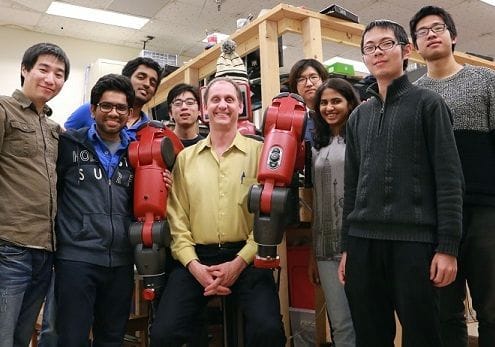![The Purdue research team [Source: Purdue]](https://fabbaloo.com/wp-content/uploads/2020/05/image-asset_img_5eb0a60ed00c0.jpg)
Research is underway to identify ways to 3D print fully functional objects.
One of the frustrating aspects of 3D printing is that the current set of machines permits only limited function within prints. Due to the typical single material used with the devices, the prints are mostly restricted to simple mechanical motion by 3D printing several parts adjacently in position for the desired actions.
In other words, you can 3D print a doorstop or mounting bracket, but you can’t 3D print a smartphone.
There has been several efforts to integrate functional materials within existing 3D printer designs, such as voxel8. The startup company introduced a development kit capable of embedding electrical circuits within a print by using a type of silver as a material to form wiring. While seemingly promising, we’ve heard almost nothing from the company for several years. One recent report indicates the company seems to be pursuing 3D printed footwear rather than electrical printing.
Thus we’re mostly stuck in simple 3D printing mode, at least until researchers develop radically different ways of 3D printing that can incorporate sensors, wiring, power and more. Such features could be used to, ultimately, 3D print a smartphone.
One team working on this problem is the Purdue Polytechnic Institute, where Prof. Richard M. Voyles’ robotics team has been inspired by the famous Terminator films. In the movies, a robot is apparently made from a liquid material that can reform on command, and yet still function. That’s a very far way from today’s 3D printing, but the question is whether 3D printing could be used to build such a device.
Purdue explains:
“Purdue Polytechnic Institute and the College of Engineering faculty are working to develop a multi-functional printer that could eventually let people print out ‘smart’ objects, including entire cellphones.
The project combines 3D structure printing with electronics printing and even algorithms to infuse sensing, computation and actuation throughout the materials, a melding of form and function.”
Professor Voyles says,
“We are synthesizing new materials that we can print in 3D that embody sensing and computation as well as structure.”
An example of this type of mechanism is a material the team has developed that is able to perform heat sensing: it shrinks or expands depending on the ambient temperature in a precise manner. If this material were added to other traditional materials, a kind of mechanical temperature sensor could be produced, for example.
Their work is planned to take several years, and I don’t doubt it. This is a radical departure from current 3D printing technology that will take time to identify and refine before commercialization.
But if successful, it could revolutionize manufacturing, as it would then be possible to 3D print custom functional objects on demand. The same benefits we see with current 3D printing could be leveraged for common functional items:
-
Low-volume manufacturing, with powerful highly specialized items appearing where they could not do so today due to the financial constraints of mass production
-
Customized functional items that match the owner specifically, such as a smartphone that fits the owner’s hand
-
Common functional components used as building blocks for many devices could be produced on demand, making the assembly of functional systems far easier
-
Production of fully functional objects in remote locations eliminates the need for shipping objects, which would be of particular interest for space exploration.
But enough dreaming; let’s await the researchers’ results.
Via Purdue











A research thesis details the incredibly complex world of volumetric 3D printing. We review the highlights.